14 © 2021, The Heights, Inc.
Monday, October 4, 2021
BC falls short to Wake Forest, losing a hard fought game 3-2.
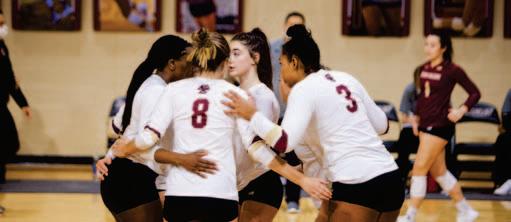 MEGAN KELLY News Editor
MEGAN KELLY News Editor
A restaurant in downtown Boston will lose its liquor license for one week this month after investigators caught underage Boston College students drinking alcohol and not wearing masks at a party in April.

According to a report from the Commonwealth’s Alcoholic Beverages Control Commission, investigators arrived at Servia, a modern Eastern Mediterranean
restaurant located on State St., on April 9 and saw approximately 21 “youthful looking individuals,” many with drinks in hand, standing by the bar.
Upon entering the establishment, the students began to “scatter” to the back of the restaurant, the report said.
“Investigators then walked to the back of the establishment and entered the dining room where they observed individuals exiting, trying to exit the premises, and/or attempting to hide from the investigators,” the report reads.
An investigation by the commission found that the restaurant violated four Massachusetts COVID-19 regulations by allowing employees and patrons to remove their masks inside the restaurant. The commission is also charging the restaurant with seven counts of underage drinking, all of which were BC students aged 19 and 20.
Servia’s liquor license suspension will begin on Oct. 18 and last through Oct. 24.
MAGAZINE
Professors navigate the transition back to the classroom after a year and a half of remote instruction.
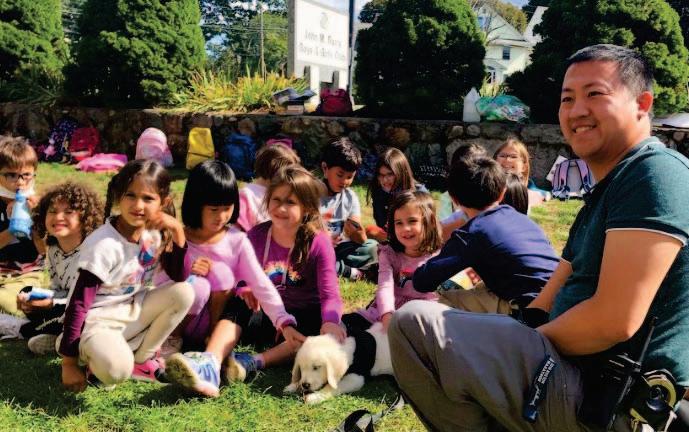
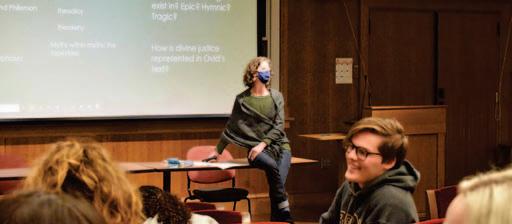
CLEMSON, S.C. — Boston College football quarterback Dennis Grosel looked downfield from the Clemson 36-yard line with 1:48 left on the clock. BC was down by six. He needed a perfect drive. Alec Lindstrom snapped the ball, and soon it was in Zay Flowers’ hands at the 49-yard line. On the next play, Grosel hit Travis Levy, who quickly darted out of bounds. Then he did it again, and again. Five completions later, Grosel found himself on the 11-yard line with a first down. Lindstrom snapped the ball, but this time it sailed through Grosel’s hands and landed on the turf. A few confusing seconds later, the refs signaled back downfield and Clemson had possession. Death Valley erupted in an 80,000-strong wall of noise as a destitute BC walked off the field, helpless without any timeouts remaining. The scoreboard flashed 19–13, Clemson.
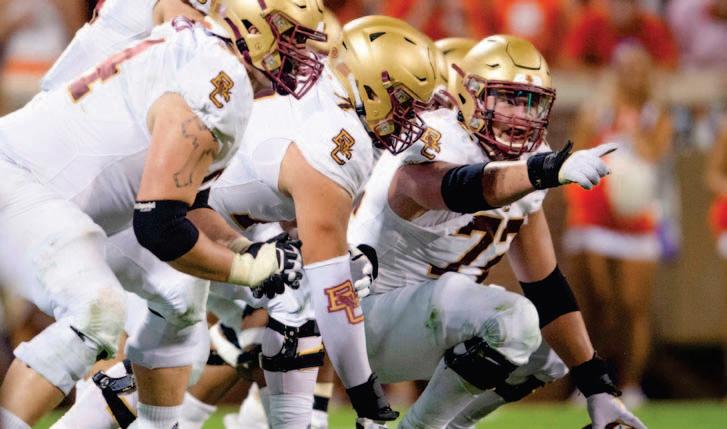

Clemson, A7
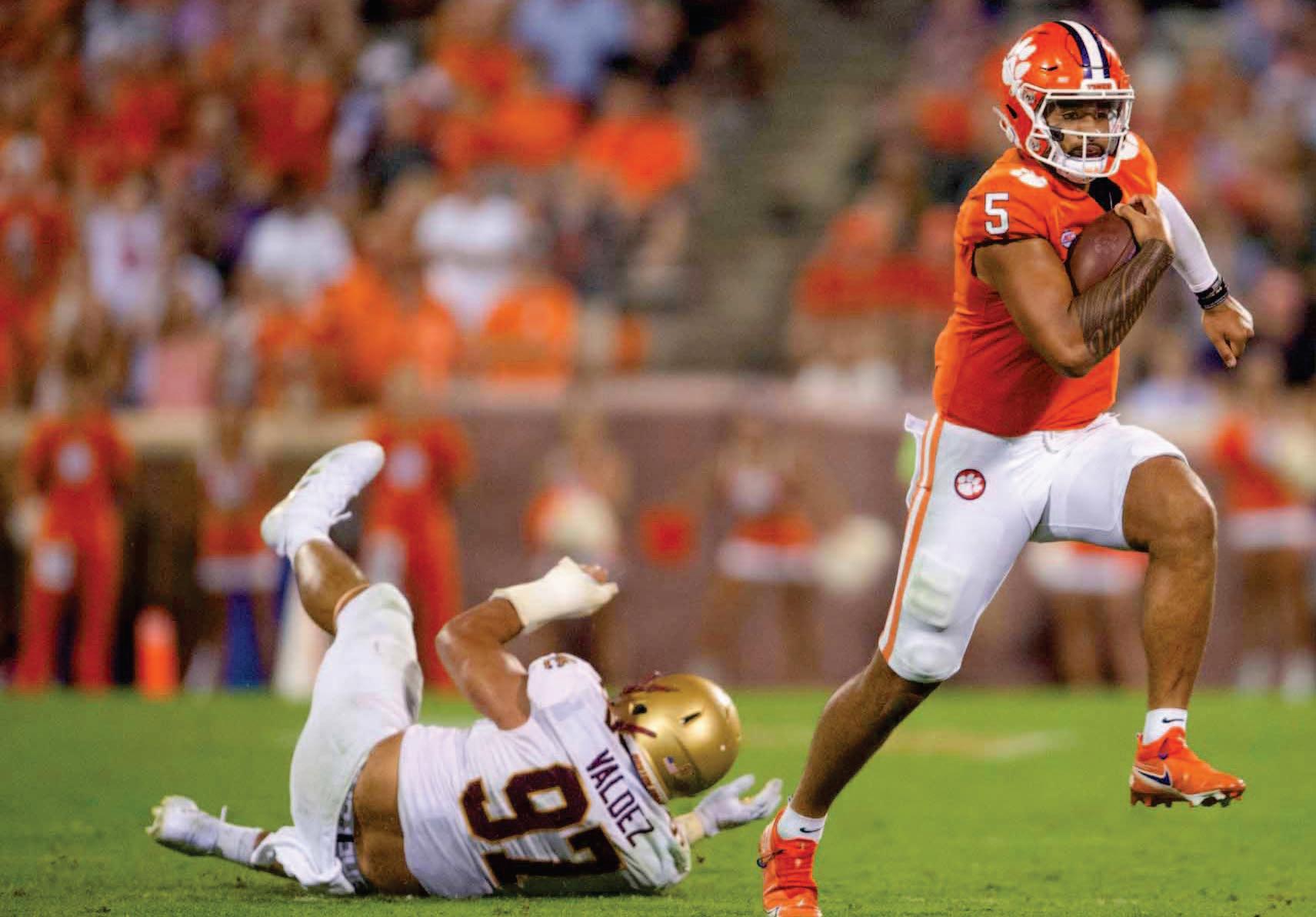
A4 SPORTS
A8
N EWS INSIDE THIS ISSUE ARTS.............. SPORTS...... OPINIONS.... NEWS........... METRO.......... MAGAZINE... A6 A7 A9 A2 A3 A4 Underage Students Cost Boston Restaurant Its Liqour License INDEX
CIII,
www.bcheights.com Chestnut Hill, Mass.
Vol.
No.
Resource Dog Leo Joins NPD See A2
www.bcheights.com Estalished 1919 Community
ETHAN OTT Asst. Sports Editor
JUST SHORT.
See A3
See
M ETRO
COURTESY OF AP PHOTO
COURTESY OF AP PHOTO
COURTESY OF AP PHOTO
PHOTO COURTESY OF ELLEN ISHKANIAN
This Week’s Top 3 Events

Fall is here. Go apple picking with CAB on Saturday at Honey Pot Hill Orchards, about 40 minutes from Boston College. With a $10 ticket available through Robsham, you can also bask in caramel apples, apple cider donuts, and a hedge maze.
Restaurant to Temporarily Lose Liquor License After Investigators Catch Underage BC Students Drinking
Servia, from
The report also details how the investigators, upon arriving at Servia, could see clearly through the front windows of the restaurant and observed the BC students drinking.
“B efore entering the premises, Investigator Keefe observed approximately 21 youthful looking individuals inside,” the report reads. “Many of these patrons did not have facial coverings and some were in possession of what appeared to be alcoholic beverages.”
After finding the entrance to the restaurant locked, the investigators
repeatedly knocked on the door to no avail. When they used their flashlights to alert a staff member and placed their identifications on the window, the investigators were finally able to enter the restaurant after the manager on duty opened the door for them, the report said.
Many of the students escaped the restaurant, but the investigators were able to identify BC students, who were aged 19 and 20 and were drinking five Moscow Mules, a Coors Light, and a White Claw among the seven of them.
According to the commission, the students presented fraudulent Connecticut, Pennsylvania, New Jersey,
and New York driver’s licenses to the investigators.
Investigators identified another three underage BC students who were not in possession of alcohol and stated that they were not drinking.
The manager on duty told investigators that he believed the BC students were of legal drinking age, and sent the investigators the approximately 37-person invitation list for the party. He also said that he personally inspected the licenses of each of the attendees at the event and asked questions about their identification information.
The manager did, however, admit to improperly conducting the party,
the commission wrote.
“[The manager] acknowledged it was an error to allow a party to begin at 10 p.m. and to serve pizzas on large tables rather than instructing individuals to be seated and providing table service,” the report reads.
At the time of the event, the Commonwealth’s safety measures for restaurants included ensuring 6 feet of distance between occupants, requirement of face coverings for workers and attendees, and the prohibition of communal serving areas.
In a statement to The Heights, a representative from Servia confirmed that the manager on duty that night
has since been removed.
“The events that took place at Servia … were the result of a poor decision on behalf of a manager who has since been removed from their position,” they wrote. “Those events in no way shape or form represent our way of business or our dedication to public health during this difficult period.”
The University was not immediately available for comment, and it is not clear whether any of the underage students received disciplinary action from BC. The Heights was unable to confirm whether any of the students received a citation from the commission.
Sennott Talks Legacy of Afghanistan, U.S. War on Terror
B Y A DITYA R AO
For The Heights S HRUTHI S RIRAM For The Heights
Students and professors alike settled into the plush armchairs of the Connolly House on Wednesday evening for the journalism pr ogram’s first in-person event since the start of the pandemic.
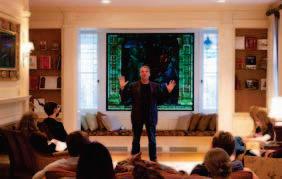
At the front of the ornate Andover Room, framed by a stained glass window, Charles Sennott, founder and CEO of The GroundTruth Project, described the evening of the attacks on Sept. 11, when Congress stood arm-in-arm on the steps of the Capitol building and sang, “God Bless America.”

“It was a moment of watching our country’s leaders, Republicans and Democrats, coming together while our country was under attack,” Sennott said. “Go from that to Jan. 6, 2021, when people
stormed the Capitol.”
In an event titled “9/11: Beyond Remembrance: Teach-In about the Global War on Terror,” Sennott spoke about his journey covering conflict in the Middle East and how the fear caused by the Sept. 11 attacks adversely affects America today.
H e also emphasized the importance of “Ground Truth,” which, a s coined by NASA, is when a person on the ground takes a measurement of the same thing as a satellite in the air.
When the readings are in conflict, NASA says to trust the human reading.
There are many truths in the world,” Sennott said. “But the truth you get by being on the ground, I think, is of the higher order because you see it and feel it and you bring it on.”
Early in his journalistic career, Sennott, then-police reporter for the New York Daily News , em -
barked on a 28-year-long reporting journey following his coverage o f the 1993 World Trade Center bombing.
“Journalists have to think, why would they want to do that?” Sennott said. “Who are these guys? Wha t were they trying to do? That journey led me to become The Boston Globe’s Middle East correspondent.”
Sennott continued to ask these questions for the next eight years, he said, often risking his life amid conflict in the Middle East.
On Sept. 11, 2001, Sennott was one of the first reporters on the ground in Afghanistan.
Although the Taliban controlled the country at the time, he said he f elt compelled to fulfill his journalistic duty in spite of the imminent danger.
“This is my role,” Sennott said. “I’m here to see what’s going on and report back to my community. And that service, it’s nowhere near as high a service as someone like a fireman or soldier defending our country, but I think it’s important, and often a task that requires c ourage. And I had courage, but I was also really afraid.”
Some fear can propel people to try to do good things, Sennott said.
“But then there’s fear that’s used to divide us,” Sennott said. “That’s how I ask you to go beyond remembrance into asking hard questions.”
Following the attacks on Sept. 11, politicians sold fear to the American people and divided them, he said.
This fear also stems from America’s decision to launch its “War on Terror” following the attacks.
“We stop thinking how we can pull together,” Sennott said. “And we start thinking it’s us against them. I think it’s a powerful contagion … Suddenly, if you’re not p art of the program, you’re against the program.”
Sennott also attributed the spread of fear to recent changes in journalism, which has strayed from grounded and personal stories crafted from the ground.
“I t hink there’s a kind of crisis of the soul in journalism, a sense of doubt in what we do,” Sennott said. “I think our task is to serve people by giving them enlightenment, forming them in working like hell to be fair, not partisan, not opinionated. Go at it by seeing what’s t here on the ground and bring it home and tell people a story.”
Sennott founded The GroundTruth Project in 2014 to
help achieve this goal.

The organization aims to raise the next generation of journalists by placing them in underreported corners of the United States and t he world, according to its website.
Sennott hopes this work will help to move journalism back in the right direction.

“I think journalism done well— journalism that is of service—is a binding agent for divided communities, pulling us together around a s hared set of facts,” Sennott said. “If we’re doing it right, it should do that.”
Sennott encouraged the American people to be proactive in t heir pursuit of transforming the United States from a country of fear to one of courage.
“There is no monumental event which is going to happen,” Sennott said. “It is not coming. It is up to small acts of hard work and local journalism to unite this country again.”
NEWS A2 MONDAY, OCTOBER 4 , 2021 THE HEIGHTS
Kinari Webb, doctor and founder of Health in Harmony—an international nonprofit tackling global heating— will speak about the intersection of her medical background and conservation efforts at an event on Tuesday at 8 p.m.
1 2
Through videos and pop-up tables featuring henna, headwrap tutorials, and trivia, the McMullen Museum aims to make the Black Muslim experience accessible to the public on Friday from 5 to 6:30 p.m.. The event is free and open to everyone.
3
A1
STEVE MOONEY / FOR THE HEIGHTS
Students gathered in armchairs for the 9/11: Beyond Remembrance Teach-In.
STEVE MOONEY / FOR THE HEIGHTS
Charles Sennott stands at the front of the Andover Room in the Connolly House.
Community Service Dog Joins Newton Police Force
 By Julia Remick Metro Editor
By Julia Remick Metro Editor
Meet the newest member of the Newton Police Department—Officer Leo.
Leo is a nine-week-old golden retriever that will serve as a community resource dog, as recommended by the Newton Reform Task Force.
“This dog will not be trained as an attack dog nor be trained to sniff for drugs,” Mayor Ruthanne Fuller said in a community update on Sept. 17. “Instead, he will be trained to provide comfort in difficult situations, assist in finding people (not crime suspects) who are lost or missing, and be out in the community with his partner meeting people and making friends.”
Community Outreach Officer Justin Lau will train Leo over the next 18 months
to support the Newton Police Department’s (NPD) community policing policy, Fuller said. With a community resource dog, the department hopes to uphold its mission of community policing by positively engaging with the community and enhancing problem-solving techniques, the department wrote in a statement.
“CRD Officer Leo will become a great asset for our community engagement efforts, assist with traumatic events, relieve sensitive situations, help children and social-emotional aspects, support officer health & wellness and even provide a search function for people prone to wandering,” the department wrote in a Facebook post.
Leo’s training will include the Puppy Aptitude Test, Puppy STAR for Dog and Handler, Canine Good Citizen, Public Access Testing, and search and rescue
certification, according to Fuller.
Leo will also be trained to provide comfort during stressful situations by instinctively lying down with people.
“He’ll also calm the vulnerable and provide assistance with social and emotional health with children,” Fuller wrote. “Within NPD, the community resource dog will also assist and support officer health and wellness.”
The community helped to select the dog’s new name by submitting name suggestions via email to the NPD.
The department received over 700 name suggestions, according to the NPD’s Facebook post.
Fuller, along with Newton Police Chief John Carmichael, Lau, and Newton Police Reform Task Force member Alison Tarmy, picked up Leo from Golden Opportunities for Independence on the morning of
Sept. 17, Fuller said.
The Task Force recommended this training location because it is an organization that specializes in the training of service dogs.
Some Newton Councilors in Favor of BC Mask Mandate
By Gavin Zhang Heights Staff
Some members of the Newton City Council raised concerns about Boston College’s lack of a mask mandate as well as the potential effects of the University’s future construction plans during a Boston College Neighborhood Council meeting on Tuesday.
Councilors Lisle Baker of Ward 7 and Alicia Bowman of Ward 6 said that BC should reconsider its decision against a mask mandate. Baker and Bowman said that some of BC’s faculty members voiced their health concerns publicly. Baker, who is a professor at Suffolk Law School, said a mask mandate is in place for all of its faculty and students and urged BC to consider the same.
“It is candidly a bit of a disappointment to us that BC is not interpreting that mandate the same way that we are in my
other life,” Baker said. “Given the nature of the breakthrough infections, I think that I would just respectfully urge the college to reconsider the issue of masking in the classroom.”
Tom Keady, vice president of BC government relations and community affairs, responded that BC’s decision against a mask mandate came from its high vaccination rate and close monitoring of COVID-19. BC has also successfully handled the recent Family Weekend, Keady said. Keady said he would bring the councilors’ comments to University President Rev. William P. Leahy, S.J. Newton Mayor Ruthanne Fuller instituted a mask mandate for public places in Newton that went into effect on Sept. 2, and the mask mandate for public spaces in the City of Boston went into effect on Aug. 27. BC students are required to wear masks in indoor spaces that the public has access to, such as dining halls and the
McMullen Museum of Art.
The BC community has a vaccination rate of 99.3 percent, BC’s Director of Government Relations Jeanne Levesque said. Levesque also said the University conducts rigorous monitoring of the COVID-19 situation on campus.
Levesque also reported on the campus construction. On the Newton side, BC is moving along with the construction of the Schiller Institute for Integrated Science and Society. BC expects to complete the building in late December 2021 and open it in January 2022, according to Levesque.
On the Boston side, BC is awaiting approval for a Conte Forum upgrade that includes upgrades for the BC basketball teams and the marching band near Gate D of the arena. Keady said that the University expects to begin these projects in March or April 2022.
Baker requested that BC ensure that
the renovation projects do not block traffic in Newton. Levesque responded that the construction would be mostly internal and would have minimal effects on traffic in Newton.
The University is conducting an internal study for a location to construct a new student center, and the site may be located in Newton, according to Keady. Keady said he could not disclose the possible sites of interest at the moment.
Keady said the University is also considering upgrading certain buildings such as the dormitories of Pine Manor College, which the University acquired in 2020.
The council also discussed the Hammond Pond Parkway Improvement Project, handled by the Massachusetts Department of Conservation and Recreation. The highway currently alternates between three to four lanes and will be reduced to two lanes to provide additional space for cyclists and pedestrians. The
first phase of the project will improve the segment of the parkway starting from Beacon Street to Route 9.
While Councilors Bowman and Baker were in favor of the project, Keady expressed concerns that it would cause traffic congestion for BC visitors. Keady urged for a holistic study of the effects of the project on the parkway, which extends from Beacon Street to Horace James Circle, further down south.
“For the people who are coming to visit Boston College, whether to work or attend, this is a huge issue—not only for us, but also the residents that live in the Chestnut Hill neighborhood area that voice their opposition to this,” Keady said.
The meeting also addressed some complaints from neighbors about BC’s activities, such as the inconveniences caused by athletic events and noises from students socializing in their off-campus residences.
By Olivia Vukelic Heights Staff
Newton Community Pride (NCP) auctioned off the 21 doors that were displayed for its public art initiative
Out Doors
Newton
Twenty-five brightly painted doors were displayed throughout village centers during the summer months. The participating artists were selected through a competitive process by the
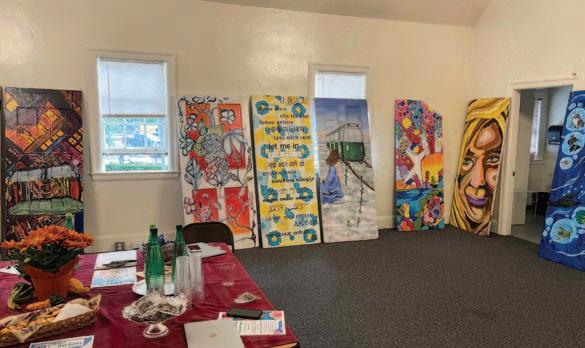
Newton Out Doors Selection Committee.
The artist selection process was competitive with 100 total applicants, Gloria Gavris, board chair of NCP, said. The proposal itself consisted of a draft drawing for the 30 by 80–inch doors.
After selection, NCP paid the chosen artists for their work.
“We spread out all the artwork with three or four in each village center to create more pedestrian activity and add
more color and creativity to our local centers,” Gavris said. “They stayed up from May to September and now we collected them all for the public art auction.”
NCP will use the money raised from this auction for a public art initiative in spring 2022, Gavris said. NCP plans to continue to expand its scope through more public art initiatives.
NCP conducted three public viewings of the doors, allowing potential bidders to appreciate the doors in person. The final public viewing was on Thursday at 1294 Centre Street, Newton Center from 4 to 6 p.m. Photos and descriptions of the doors are also available online.
Online bidding for the doors closed on Friday at 7 p.m.
“There are a lot of creative ways that they could be used now that they’re no longer out in the world,” Dinny Starr, vice chair of NCP, said. “They could go back outside in your garden or some people have talked about using them as a headboard or tabletop.”
Bids for the doors ranged from $100 to $525. “Inside and Outside of
the Virus” by Sophy Tuttle received the highest offer of $525. All 21 doors sold during the auction.
Twenty-five doors were donated for the project, 20 from a homeowner undergoing a house renovation and five from the Nathaniel Allen House which recently finished an eight-year-long restoration project by the Newton Cultural Alliance.
Of the 25 original doors that were on display, four doors were not available through the auction.
Amanda Beard Garcia’s door titled “Por Por” depicting her Asian grandmother was vandalized in July and then moved to the front of Newton City Hall. The piece will not be included in the auction due to the damages. The other three doors were too damaged and worn away from months of public display to be included in the auction.
“Some of the artists that are represented here are accomplished professional muralists,” Starr said. “They knew what they were doing, putting the artwork up and making sure that it was weather safe.”
Starr specifically mentioned Tuttle, a renowned muralist in Massachusetts who recently completed the mural “Fear” in East Boston as part of the Sea Walls Boston mural festival. Tuttle’s door, “Inside and Outside of the Virus,” expressed an “inward” lifestyle with the inner door and nature, which was used as an escape throughout the pandemic, with the outer door, according to the auction website.
Along with Tuttle, the local artist couple Grey and Leslie Held painted the doors “Let Me In,” which features an original poem and the phrase “let me in” in several different languages.
Shihui Angela Zou, a Newton North High School student, painted her doors as an appreciation for Chinese culture and history. The doors feature beautiful cherry blossoms and the string instrument, the erhu.
“One of the things that was really important to us about the project was to bring art where people were,” Gavris said. “After COVID, dreary winter and spring, I think more than ever the arts are important to bring to the community.”
METRO A3 MONDAY, OCTOBER 4, 2021 THE HEIGHTS
PHOTO COURTESY OF ELLEN ISHKANIAN
Leo, the new NPD puppy, took a ride in a miniature police car.
‘Newton Out Doors’ Artwork Sold
Online Auction
Newton Community Pride displayed the 21 doors for bidders at public viewings.
in
OLIVIA VUKELIC / HEIGHTS STAFF
Read the rest of this story at bcheights.com
AGAZINE
Processing and Proceeding: Professors Transition From Remote Learning Back to the Classroom
By Anna Lonnquist Magazine Editor Stephen Bradley Assoc. Magazine Editor MC Claverie Asst. Magazine Editor
The 2021–22 academic year has brought many changes across Boston College’s campus. As new and returning students prepared for a more normal year of college with significantly fewer COVID-19 restrictions, professors prepared to take on their own set of new challenges—returning to in-person instruction.

In terms of time, the last year and a half of distance learning has been nothing more than a blip in the careers of the many BC professors who have spent years teaching fully in person. The impacts of other aspects for these professors, though— the adaptations they underwent and lessons that have stemmed from the pandemic—have been immeasurable.
Here and Now: Returning to an In-Person Environment
The return to the classroom has been long-awaited by both students and professors—but the shift has been especially pronounced for BC’s professors who were entirely remote during the 2020–21 academic year.
“I think I thought, you know, after … a year and a half of remote teaching, just walking back into the classroom, I’d be ready to go in the same way, because I’ve taught for several years,” assistant professor of English Christy Pottroff said. “And you know, I take my teaching very seriously, but I think I was rusty.”
Despite having years of in-person teaching experience prior to the pandemic, associate communications professor of the practice Celeste Wells felt the same sense of difficulty when going back to the classroom, she said.
“Teaching is performance … we’re on stage all day long,” she said. “[Last year] we all had to learn how to sit still and teach to a fixed camera, and so, then you move back into
… the dynamic stage. The first week, I certainly came home and said, ‘Oh my gosh, I don’t feel like my mouth is working right.’”
Clinical instructor in the Connell School of Nursing Dorean Hurley had a shorter transition period between online and in-person instruction, as nursing classes in the summer of 2021 were held in person. She said that she felt both excited and nervous before lecturing in front of a large class again.
“It was nerve-wracking a little bit because … I was completely remote in the spring semester, so I’m always nervous on the first day of class, no matter what. But I think I was a little more anxious, the first couple of classes in the summer, and for the
the pandemic—the world is also a different place than it was two years ago, Thatcher said.
“It requires rethinking everything again almost from scratch,” Thatcher said. “[I’m] needing to think about masks, needing to think about recording—which I never would have done before—for when a student is out for any reason. The technology that I have to juggle is so much more than ever before … learning how to project my voice in a mask is a challenge.”
Because of the prolonged period of teaching online, many professors—especially those who were entirely remote—started getting fully comfortable with being on Zoom.
Thus, shifting online lesson plans and content back to the classroom had a unique set of obstacles, assistant professor of classics Hanne Eisenfeld said.
“Just thinking about the technological adjustments of how do you make what worked on Zoom into something that will play in the classroom—what was on the board, what needs to be printed,” Eisenfeld said. “But [also] on the smaller scale, where I could take the theory of the class, and then sort of translate it into physical space.”
Initial adjustment periods aside, Wells said the return to in-person learning is important.
tect themselves.
“So I stayed online for both semesters for, you know, health reasons, as I’m sure anyone would say,” Thatcher said. “I think that I found in the fall that the system I came up with was working pretty well, and so I basically then did the same thing in the spring.”
Some professors had other reasons to remain online, such as their families’ health. For Pottroff, who has an unvaccinated child, a brother with brain cancer, and other highrisk family members, teaching virtually allowed her to keep her family safe, she said.
really bring out the material and let people engage?’ So I think that was more helpful.”
For Thatcher, the hardest part was reimagining the format of his classes. He felt unprepared and under trained at first, he said, but by the beginning of the semester, he became more comfortable.
Another adjustment some BC professors faced was teaching virtually at the same time as their partners. Eisenfeld and Thatcher, who are married, had to plan how to best share their space at home.
fall semester,” Hurley said.
Though she taught in-person classes during the summer, she said, preparing on a larger scale of the fall semester was still an adjustment.
Hurley said that she needed to hone her social skills again, especially after having limited human contact for more than a year.
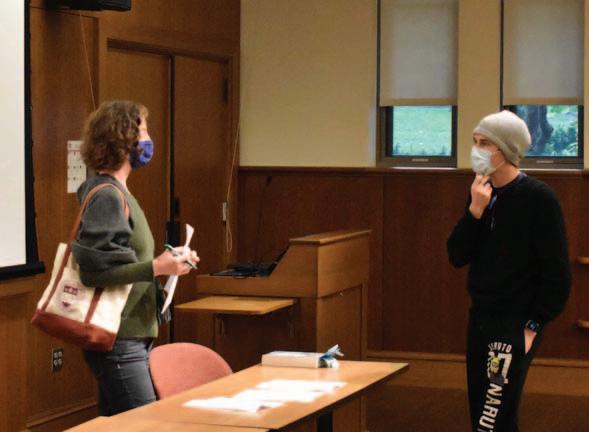
Another part of the adjustment was coping with the idea that COVID-19 may be transmitted in her classroom. From her perspective as a healthcare provider, seeing students without masks was worrisome.
“As a healthcare provider … that’s been a real struggle for me to see students in class, sitting right alongside of each other both people not wearing masks,” she said. “That I have a problem with only because I’m a nurse, and what we do in the hospital setting is not what we’re doing in the classroom setting, so … I worry about transmission,” she said.
Compared to last year, when COVID-19 protocols were uniform and strictly enforced, many decisions were left up to professors this year, such as what to do if a student misses class due to isolation.
Increased guidance from the University on these matters would have also helped with the transition back this year, assistant professor of the practice in the classics department Mark Thatcher said.
The challenge hasn’t just been rustiness and the uncertain state of
“I think in the end it’s healthier for everyone, even if it’s hard, and I don’t mean COVID, [but] I think developmentally, it’s good for people to have to interact with others,” Wells said. “I think … we’re all going through growing pains right now.”
Some professors have also noticed a change in students after a year and a half of modified classroom settings.

“It’s not like all students are delighted to be doing homework all the time, but … they are energized to be around others,” Wells said. “There’s a vibrancy among students right now, where I think … we’re all a little more grateful for what we have versus taking it as the status quo.”
Associate professor of communication Michael Serazio also said that his students have shown their enthusiasm and gratitude to be back fully in person.
“These have been probably the best ... first three weeks of a semester that I’ve ever experienced as a professor,” he said. “The energy, the vibe is the best … in my career of teaching. I mean … it’s obvious but it’s just [that] when you’ve been deprived of something, you’re that much more appreciative and energetic about it.”
2020: A Reimagined Academic Year
Because of the unpredictable and contagious nature of COVID-19, many professors chose to remain online throughout the duration of the 2020–21 academic year to pro-
For professors teaching large classes or classes with enough international students, the University made the call that certain classes would run online.
Once professors decided or were
“The biggest challenge is that we have an office that we share … it required a certain amount of planning about who is going to be where when, and awareness of sound traveling through the walls, so I’d hear Greek being taught while he was listening to my [classical mythology]
told by the University to use an online format, they were tasked with adjusting course material and methodology. The good news, Eisenfeld said, was that they could apply the lessons learned during spring 2020’s hectic transition to online as they entered the fall of 2020.
“The following academic year we had the summer to think about how to retool our classes, the CTE [Center for Teaching Excellence] was extremely helpful in providing guidance for that,” Eisenfeld said. “And so it was a much more considered process of thinking about, ‘How can I use those digital tools to
class, but it was okay,” Eisenfeld said.
Once the semester was underway, professors teaching discussion-based classes had to be extra intentional about fostering conversation over Zoom.
Associate professor of English Robert Lehman said his upper-level classes usually range from 12 to 15 students, allowing for students to easily jump into the conversation while in person.
Over Zoom, establishing this natural flow was much more difficult.
See Professors, A5
A4 MONDAY, OCTOBER 4, 2021 THE HEIGHTS
M
VIKRUM SINGH / HEIGHTS EDITOR
VIKRUM SINGH / HEIGHTS EDITOR
Professors who taught online last year return to in-person instruction.
Transitioning back to the classroom, professors can utilize classroom space.
VIKRUM SINGH / HEIGHTS EDITOR
In-person classes allow professors to interact with students more authentically.
from A4
“I was using, you know, the hand raise function … things like that, and somebody who had a really immediate reply to a point that someone had just made then wouldn’t get to speak because I just go through them in order,” Lehman said. “It just kind of felt like a lot more … call and response, and a lot less organic communication.”
Professors who used hybrid or in-person models, like Serazio, also had to adjust to not only teaching in a mask, but also delivering lectures to students whose faces were half covered. For years, he relied on nonverbal cues to understand if students were processing the material—which became impossible.
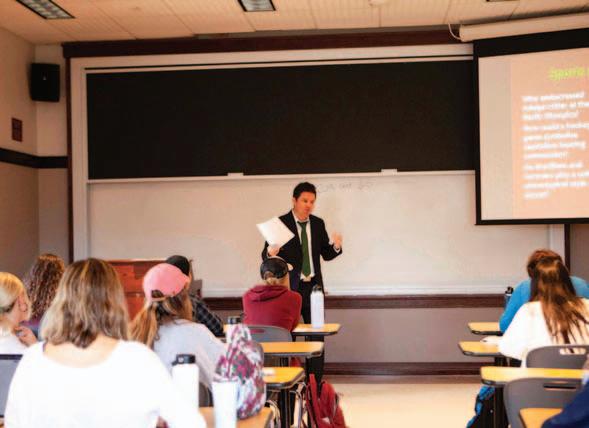
“Especially that first month, my brain as a … teacher was trying to process the fact that I had absolutely no clue whether any of the material was … landing in an effective way,”
situation was surreal, difficult, and exhausting, he said. Beyond recognizing that nobody was experiencing a normal year, he also tried to create space to check in on his students’ mental state, he said.
“There were moments where I would try to have class sessions that were really just around coping and checking in with people’s mental health,” Serazio said. “Like, … let’s just all kind of talk about what’s getting us through this difficult year, what strategies you’re using, where are you finding joy, where are you finding rejuvenation.”
Apart from academics, many professors also missed the authentic in-person interactions and connections with their students. Hurley particularly felt this lack of interaction with her students because she teaches courses of varying levels in the nursing program. She usually has the chance of getting to know the nursing students as freshmen, but teaching online prevented her
Wells to hone in on the importance of being clear in her communication to her students, which is one way to promote a sense of security in her classroom setting, she said.
“What I learned is that … people can’t learn if they don’t feel safe,” Wells said. “Before, [students] had a normal syllabus that they could follow, but I immediately got them a brand new one that was online that could say, ‘Here’s how you can now understand what we’re going to do going forward,’ and sometimes just having that much clarity in a world that’s completely unclear … can prove useful.”
A common effect of the 2020–21 school year—for professors and students alike—was Zoom fatigue, where individuals would find difficulty in paying attention after looking at a screen for several hours. To combat this and to ensure student engagement, Thatcher divided his class size and lecture time in half to facilitate a more intimate discussion.
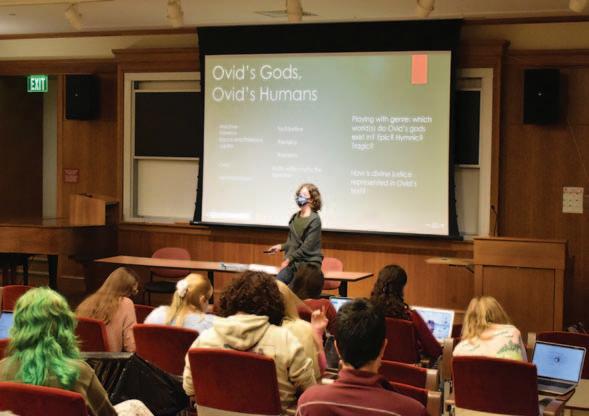
“I tried to keep the Zoom room small for my larger classes—which were 40 students—so I actually divided them into two sections of 20 students each,” Thatcher said. “And rather than meeting as a whole group for an hour and 15 minutes, we met for 30 minutes each … I tried to be really focused in those classes. I think students were into that.”
Eisenfeld also divided her 75-minute lectures into halves. Having a condensed class time meant that she had to rethink how to best use her time, she said.
Pottroff emphasized group work in her remote classes. She said that establishing a sense of community within the classroom is something professors can forget about, but the heightened sense of isolation during the pandemic reminded her of its importance.
“I did more sustained … group work [during] the remote semesters, and I think that that was really valuable,” Pottroff said. “I like to help foster those connections and friendships in a way, and it felt really important during the pandemic when everyone was isolated, you know that those relationships could be really meaningful.”
The struggle to foster a class community was multiplied for professors like Wells who taught asynchronous sections.
have also preserved methodological approaches from online learning in their in-person teaching routines.
After being forced to administer exams online last year, Thatcher found many benefits—from not worrying about a student missing the exam to not having to struggle to read handwriting—and has continued to administer them online this year.
So far this year, Wells has had both virtual and in-person office hours.
She said that this method is useful because it caters to students’ availability and comfort levels.
“They can do virtual or in-person office hours with me, depending on how they feel, or just the space they’re in in a particular week,” Wells said. “It’s been nice because it’s giving them more flexibility in the way they connect with me, if they’re more comfortable … online. For me to be able to have those different options for them.”
ingfully, and so that’s one of the things I’m keeping,” Eisenfeld said.
Reflections and Lessons Learned
Ultimately, a year and a half of virtual teaching provided professors the opportunity to reflect on their own teaching practices and learn from the processes of online learning.
For Serazio, who was previously open to letting students use technology in the classroom, the time being virtual caused a shift in his views—no screens are allowed in his classroom, he said.
“The point of [the] pandemic was to change you,” he said. “The point is not to go back to normal. The point was to go back to something … that’s better than normal, it’s different than normal. And in some small way ... it was sort of the realization of ... the negative energy that screens can drain out of the room.”
Serazio said. “As a professor … especially if you’re like a high self-monitor like I am … you’re constantly relying upon nonverbal cues, facial expressions, things like that, to try to gauge whether it’s working, whether the materials are working, whether it’s understandable, enjoyable … so it was just completely surreal and exhausting.”
Even though he was teaching in the classroom, Serazio felt the same sense of choppiness that Lehman did online, and said that he had to work twice as hard to foster energy and interaction.
Online classes challenged both professors and students to adapt with regard to learning, but the adjustment went beyond this—professors had to take into account how the pandemic impacted students outside of the classroom as well, Serazio said.
He tried to preface class by reminding his students that the current
from doing so.
“I get to know some of the students as freshmen in the intro professional nursing class, and you weren’t able to do that,” Hurley said. “And so then they follow up and come into a big fundamental class in nursing, and I don’t know them as well as I did in previous years, so … that’s another challenge.”
Successes and Solutions
Though professors encountered many obstacles while teaching remotely, their temporary solutions to these problems taught them lessons that they would not have learned in a normal academic setting. Now, after the return to in-person instruction, many of these temporary lessons have stuck.
During the pandemic, the difficulty of processing everything that was happening worldwide prompted
Wells recognized the danger of students simply turning in assignments without ever engaging with the professor or classmates, which led her to implement more intimate sections of her courses, she said.
“I designed a portion of all my asynchronous classes called tutorials where they had several different choices of times that they could come, and we would be in small groups, like 10 people, online,” Wells said. “We would just discuss stuff, we would just have conversations about [the] material and how it connected to the real world, and I think that worked really well from a time perspective because I had them at all different … times so that the international students would be able to attend.”
The successes stemming from intentionally carving out space for discussion and connection have continued to shape this year for many professors. Some professors
During the transition back to in-person teaching this fall, Eisenfeld felt a push to combine the best aspects of each format, but she recognized this goal was unattainable across the board.
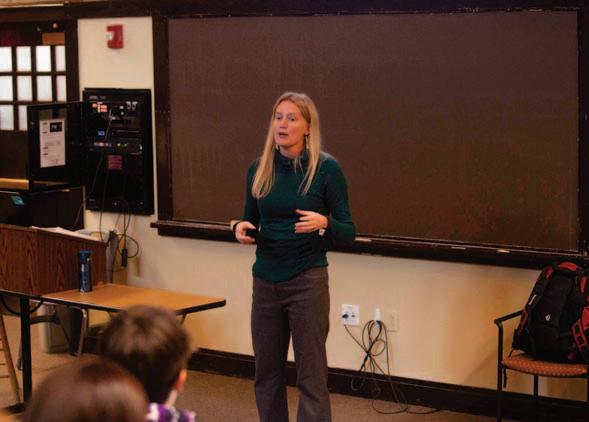
“In some ways, there’s a temptation to take all the things that worked on Zoom, and then think of all the things that work in person and try to do them all, which is terrible because that’s too many things for any given class,” Eisenfeld said.
She has devoted herself back to the mode of in-person teaching, but still finds value in remote-learning tactics like Canvas discussions, she said.

“Having made them part of that hybrid asynchronous/synchronous teaching last year, I saw that [Canvas discussions] really gave students a chance to dig into the material and develop thoughts before discussion, and then discuss much more mean-
Wells said that the pandemic allowed her to learn from her own teaching practices and forced her to think about how to achieve learning outcomes in a new environment.
“We have to find a new way to function,” she said. “I think that’s something that has adapted, but the truth is, we’re only three weeks in and so ... there’s gonna be a learning curve for all of us, students included. The shifts we’ve all experienced over the last several years have been really massive.”
Wells also emphasized the importance of tending to the whole student.
“If students are struggling, I hope they remember they’re not alone with these challenges and they should reach out to friends and faculty and staff across campus that they trust so that they can really work through this new world together, rather than apart or in isolation as we’ve been over the last couple of years,” Wells said.
MAGAZINE A5 MONDAY, OCTOBER 4, 2021 THE HEIGHTS
Professors,
IKRAM ALI / HEIGHTS EDITOR
Despite COVID-19 uncertainties, Wells said learning in person is important.
VIKRUM SINGH / HEIGHTS EDITOR
Serazio’s discussion-based classes have benefited from being in the classroom.
Eisenfeld combined lessons from online learning with her in-person routines.
VIKRUM SINGH / HEIGHTS EDITOR
IKRAM ALI / HEIGHTS EDITOR
The past year and a half highlighted the importance of caring for the whole student.
Symbolizes Self-Growth Through Combat






 BY ALICIA KANG Asst. Arts Editor
BY ALICIA KANG Asst. Arts Editor
Shang-Chi and the Legend of the Ten Rings could have easily been a lower budget, half-baked attempt at diversity sprung up to take advantage of America’s recent fascination with Asian media. In a surprising turn of events, the film’s gripping fight scenes, thoughtful character design, and electric soundtrack actually make it one of Marvel’s most empowering movies.
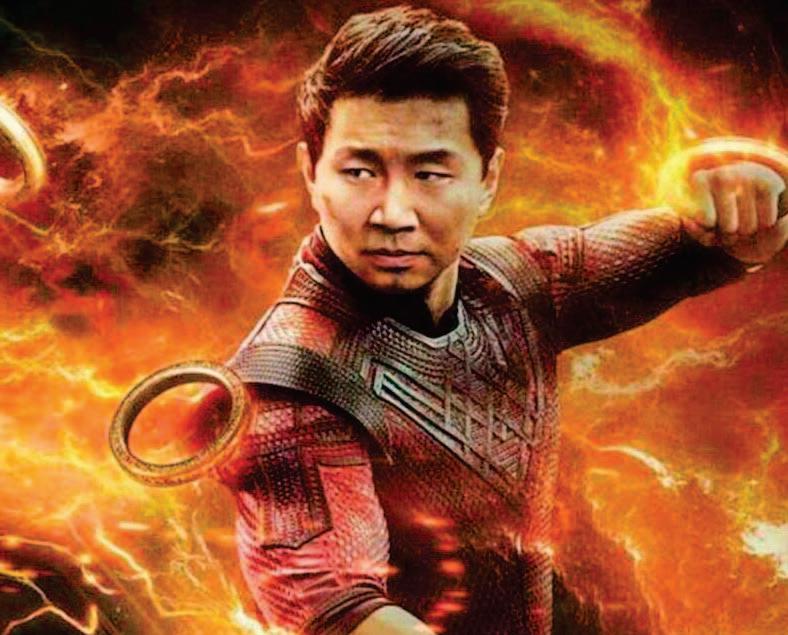
The film starts by recounting the legend of the ten rings, which gave Xu Wenwu (Tony Leung), their wielder, otherworldly power. Then, in a stark tonal shift, the movie cuts to Shang-Chi (Simu Liu), Wenwu’s son, who currently lives in San Francisco parking fancy cars

as a valet driver. Though he escaped his father’s ruthless empire years ago, ShangChi’s old life comes back to find him when Wenwu sends his henchmen to capture Shang-Chi’s amulet.
In most action films, flourishes and spins in combat seem extraneous and often detract from a fight’s impact. In Shang-Chi, however, the different fighting styles relate to each character’s development and mindset. Shang-Chi’s initial actions are fierce and forceful, and he often pushes violently outward, preventing enemies from getting too close. But, by the end of the film, he learns to open up, switching from clenched fists to open palms. His movements become more relaxed, and he isn’t afraid to let his attackers draw close before he turns their
own strength against them.
The film is also full of powerful, multi-faceted women, from Shang-Chi’s aggressive, tough sister, Xu Xialing (Meng’er Zhang), to his hilarious friend Katy (Awkwafina) to his kind, supportive Aunt Jiang Nan (Michelle Yeoh). Perhaps most importantly, Aunt Jiang Nan teaches Shang-Chi how to fight with grace and self-assurance. The film masterfully showcases a range of Asian female characters, all with their own well-developed backgrounds.
Shang-Chi is set apart by a tone of surprisingly straightforward realism. ShangChi somehow punctures the veneer of movie magic in the best way possible, making viewers feel as if Shang-Chi’s story actually takes place in our world.
Lil Nas Navigates Romance and Heartbreak on Album
BY ORLINKA KEREERE For The Heights
’Tis the eve before cuffing season and Lil Nas X has got all the boo’d up hopefuls and boo-less listeners covered with every emotion on his latest album, Montero, released on Sept. 17. Montero Lamar Hill (aka Lil Nas X) serves up a fresh mix of rap and rock on this heartfelt, youthful, and strikingly resonant work of art.

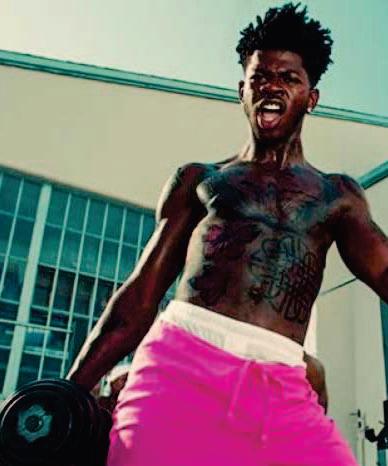
Playing right into the hands of the industry, Lil Nas X has mastered the art of making less than three-minute long TikTok-worthy, chart-topping, platinum-selling songs. The album, with 16 songs, barely squeaks by the 41-minute mark.
At 22, Nas has more to say about love
and heartbreak than most young adults.
His take is raw and heavy-hitting which makes his album a joy to listen to. While his rap songs create little to no effect, the soft rock and pop songs are playful and head-bop worthy.
The more upbeat song that almost crossed the line into whining is “THATS WHAT I WANT,” but it strikes a chord when he explains, “Look, you know it’s harder to find in these times / But I got nothin’ but love on my mind.” Nas could be alluding to COVID-19 restrictions making it even harder to find that special someone, but he could also be alluding to the difficulty of being queer and finding real romance in a world where it’s easier to stay quiet about one’s sexuality than to be open about it and face verbal, emotional,
and psychological abuse.
“LOST IN THE CITADEL,” another soft rock piece, is relatable to all, as it details his self-deprecating thoughts over how he keeps going back to his onenight lover for quick satisfaction with someone he thinks is emotionally closed off. Singing “I need time to realize that I can’t be yours” creates an inescapable chill effect.
One of the best songs on the album, “VOID,” although much slower than the rest, is an upbeat ballad sung for “Blue” (Nas’ love interest). The song crescendos into the perfect nighttime, windows-down drive along a winding road to end a less than perfect summer season in the hopes of a more promising fall.
MUSIC

New Season of 'Sex Eduction' Buckles Under Plotlines
BY PATERSON TRAN For The Heights
The long-awaited new season of Sex Education was released on Netflix on Sept. 17, immediately garnering attention from its fandom. The first episode has an explosive start, montaging sex scenes between the growing list of characters.
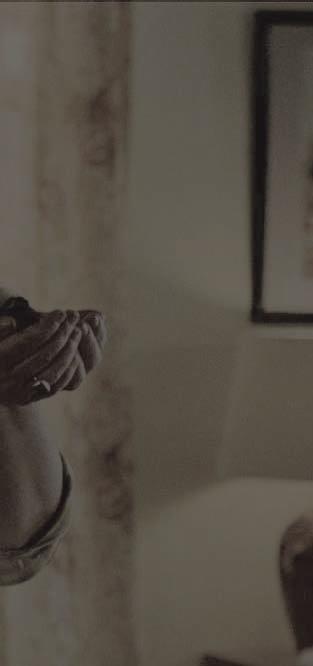
The pace of Sex Education picks up somewhat shortly after the barrage of cliff-hangers that concluded season 2, released over a year and a half ago. Otis (Asa Butterfield) and Maeve (Emma Mackey) resume their awkward impasse, Adam (Connor Swindells) figures out his new relationship dynamic with Eric (Ncuti Gatwa), and beloved sex therapist Jean (Gillian Anderson) tackles impending
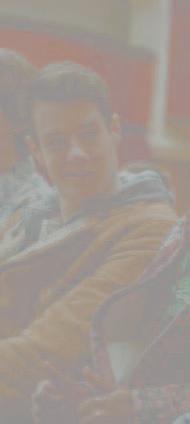
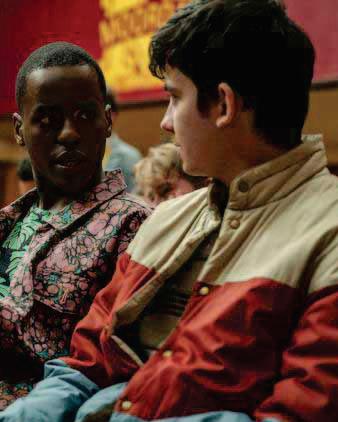
motherhood.
Adamant on further complicating the show, Sex Education adds a host of new characters and storylines that quickly stretch the show thin. For example, new non-binary student Cal, played by recording artist Dua Saleh, gets only a few minutes of screentime within the first several episodes. The show attempts to revive plotlines with new introductions, but it fails to commit to ridding itself of old ones—the result is a show that leaves the viewer perpetually unsatisfied and uninterested. Episodes are spent “checking in” on an array of side characters in their never-ending conquest of sexual sequences that appear more slapstick than dramedy.
But, what Sex Education fails in con-
cision it makes up in humor and shock. Continuously the show takes sudden comedic turns and surprising twists. It doesn’t fail to make viewers laugh at outrageous and relatable risqué scenarios and taboo subjects. Like the first and second seasons, Sex Education is able to formulate a show that reaches topic matters far and wide, such as LGBTQ+ sexuality, performance insecurity, sexual assault, and now, pregnancy.
With the onset of new plots, Sex Education tries to exceed the expectations of its starved fandom. Unfortunately, with its inability to contain itself within the narrower cast of its previous seasons, Sex Education underperforms and underwhelms a viewership that survived a pandemic while awaiting its production.

‘The Starling’ Misses on Blending Humor With Grief










 BY SHAUN TAXALI Heights Staff
BY SHAUN TAXALI Heights Staff
The Netflix film The Starling, released on Sept. 17, attempts to combine humor and sorrow to analyze a couple's grief following the loss of an infant daughter. While keeping a light, heartfelt tone, the emotional speedbumps that attempt to draw audiences in instead feel downright cringey. The Starling is a face palm of a watch, threatening to test audience members' patience with the presentation of an emotionally stuffed story that after further glance is as hollow as it is tedious.
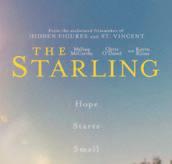

The usually wonderful Melissa McCarthy stars as Lily, who is left grieving from the recent death of her infant daughter. All of that seriousness disappears once Lily
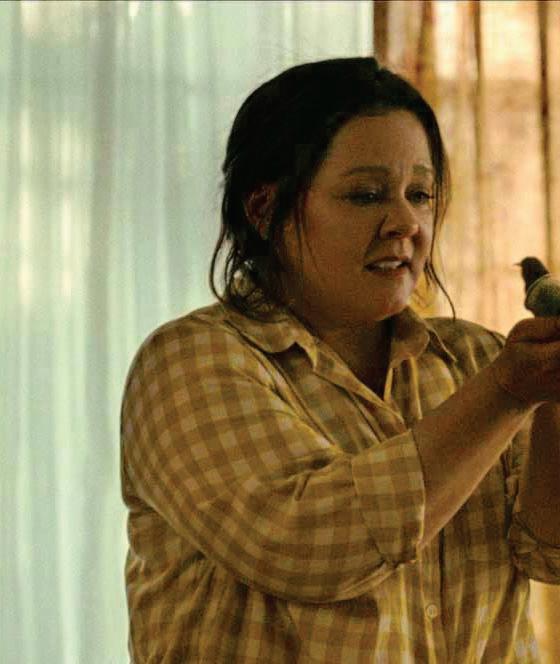
begins being berated by a bird throughout the movie. The movie proceeds with scenes where McCarthy physically talks to the bird, like a patient to a therapist, about how she feels about her daughter's death.
After being directed to a doctor, Lily visits him without the knowledge that he has now become a veterinarian. Larry Fine, played by Kevin Kline, ends up developing a friendship with Lily. As the bird, which Fine identifies as a starling, continues to visit Lily, she also begins to develop a connection with the bird, at first hoping to kill it until she begins feeding it.
The obvious metaphor of the starling being representative of the couple's daughter fails to come across as meaningful, and instead is a groaning example of a
writer trying too hard to get an audience teary-eyed. While the premise of the film itself is hard to get behind, the real struggle is the dialogue between characters. Packed with corny jokes, odd answers to seemingly normal questions, and too many phony-feeling monologues between Lily and Jack, it’s difficult to emotionally invest oneself in the film when everything the audience is supposed to feel is forced.
While The Starling is supported with strong cinematography, such as shadows over depressed characters, the film is a difficult watch. Audience members are better off watching McCarthy in Bridesmaids or Can You Ever Forgive Me?, where she is supported with a stronger script and a clearer premise audiences can actually enjoy.
ARTS A6 MONDAY, OCTOBER 4, 2021 THE HEIGHTS
MOVIE
PHOTO COURTESY OF MARVEL STUDIOS
PHOTO COURTESY OF COLUMBIA RECORDS
‘MONTERO’ LIL NAS X DISTRIBUTED BY COLUMBIA RECORDS RELEASE SEPT. 17, 2021 OUR RATING
TV
PHOTO COURTESY OF NETFLIX
‘THE STARLING’
RELEASE SEPT. 17, 2021 OUR
THEODORE MELFI DISTRIBUTED BY
NETFLIX
RATING
MOVIE
PHOTO COURTESY OF NETFLIX ‘SHANG-CHI AND THE LEGEND OF THE TEN RINGS’ DANIEL CRETTON DISTRIBUTED BY MARVEL STUDIOS RELEASE SEPT. 3, 2021 OUR RATING ‘SEX EDUCATION’ LAURIE NUNN DISTRIBUTED BY NETFLIX RELEASE SEPT. 17, 2021 OUR RATING
‘Shang-Chi’
Clemson, from A1
“We had a chance to take it in the fourth,” BC head coach Jeff Hafley said in his postgame press conference. “Certainly I could have coached a better game. I’m proud of our players. We’re a team—we win as a team, we lose as a team. There’s no point in pointing fingers.”
BC (4–1, 0–1 Atlantic Coast) had chance upon chance throughout Saturday night’s game at No. 25 Clemson (3–2, 2–1 Atlantic Coast). On the drive prior to the one that cost them the game, the Eagles had possession with 1st-and-10 on the 37-yard line. Instead of pushing downfield, the Eagles marched themselves upfield. An ineligible receiver downfield and two back-to-back false starts saw BC suddenly facing 1st-and-25 back at midfield.
“It was loud,” Hafley said. “As much as I thought we prepared for the noise, this is the first time in two years that we’ve been in an environment like this. We need to do a better job of preparing, and that falls on me.”
That drive eventually ended in a turnover on downs, but the Eagles miraculously got another chance.
BC’s defense stepped up as it did all game, using all three timeouts and stopping Clemson on 3rd-and-3, which forced a punt. The Eagles failed to capitalize, but their defense kept them relevant throughout the evening.
“We definitely feel like we’re one of the best defenses in the country,” Brandon Sebastian said after the game.
Clemson’s offense might lack its firepower of years past so far this season, but it is still the strongest offensive attack the Eagles have encountered. Still BC’s defense held Clemson to just 19 points on a touchdown and four field goals.
The Tigers totaled 438 yards—207 through the air and 231 on the ground. Those numbers appear troublesome from a defensive standpoint, but BC’s performance on third downs rendered Clemson’s productivity on first and sec-
ond down almost irrelevant. In 14 tries, BC only allowed Clemson to convert on three of its third downs. The Eagles also stopped the Tigers on their one fourth down attempt.
“Overall, what a great effort by the defense,” Hafley said. “Holding them to the field goals after sudden changes—I’m proud of those guys, and I think the defensive staff did a terrific job.”


BC’s defense did not just get stops, it got stops at the right time. In the second quarter with the game tied 13–13, Clemson quarterback DJ Uiagalelei delivered a 33-yard pass to Kobe Pace, who Jaiden Woodbey took down at the BC 43-yard line. The Tigers were marching downfield and needed just one more first down to get within field goal range and take the lead. Clemson fought for a 2nd-and-5, but BC only allowed the Tigers one more yard on their next two plays. Instead of taking the lead, Clemson was forced to hand the ball back to the BC offense, which promptly turned it back over.
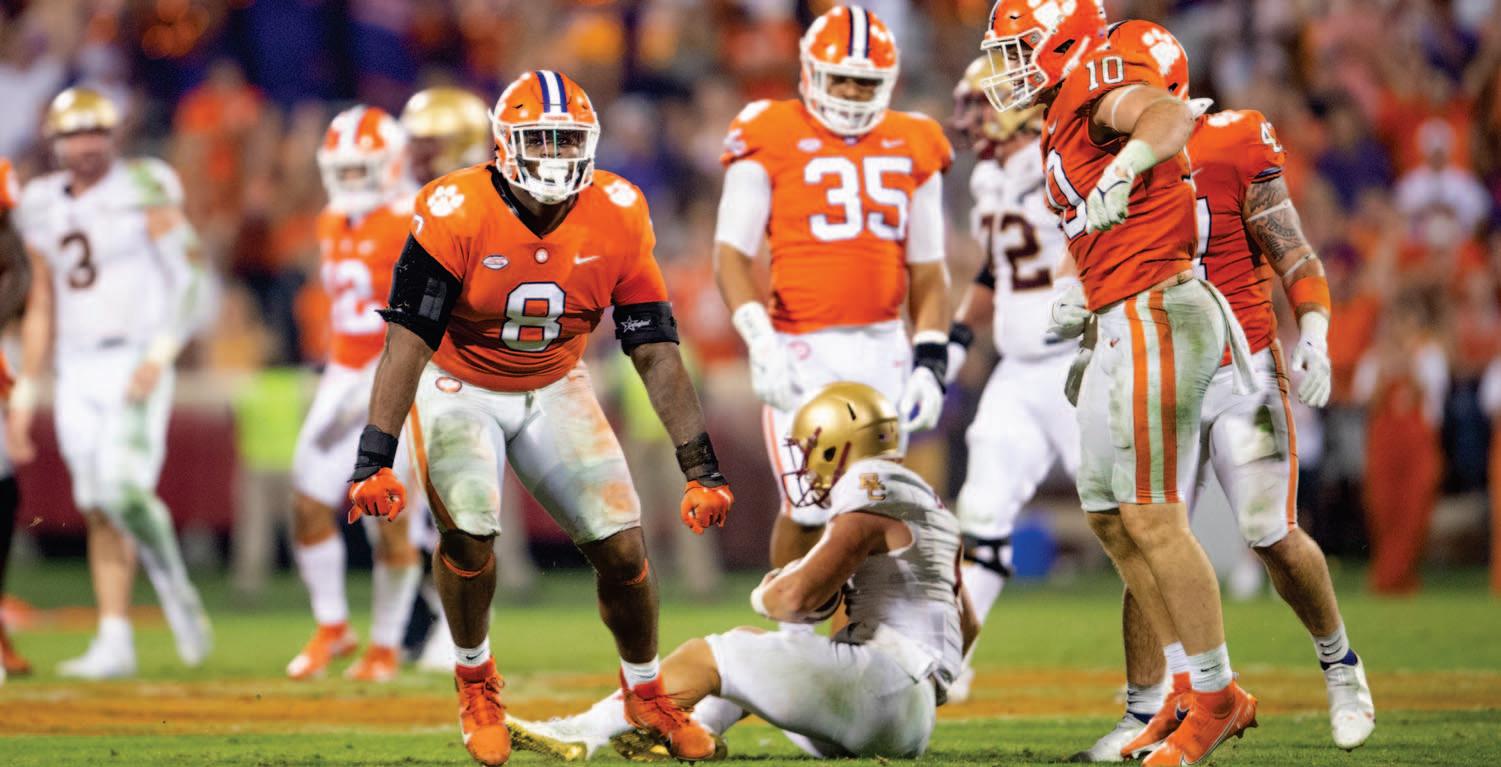
This pattern repeated itself throughout the game, with each of BC’s defensive stops and ensuing drives foiled by a Clemson stop or BC turnover.
The Eagles turned the ball over a total of three times, two of which came on interceptions and one that marked the game-deciding fumble. Despite his turnovers, Grosel played his most statistically impressive game of the season Saturday night, recording 311 yards on 23-of-40 passing.
With Grosel’s yardage came a slew of receiving help. Seven different Eagles hauled in passes, five of whom finished for over 35 yards. Trae Barry led the BC receiving attack with 82 yards on seven receptions. Barry’s performance Saturday was the most BC has used a tight end since Hunter Long last season. Fellow tight end Joey Luchetti also tallied yardage on two receptions for 58 total
Read the rest of this story at www.bcheights.com
BY EMMA HEALY Sports Editor
Three years in a row, Boston College football has made the trek down to Death Valley to take on Clemson. Three years in a row, the Eagles have faced a cacophony of noise at one of the loudest stadiums in the country. Three years in a row, they’ve taken the long plane ride home with a devastating loss looming over their heads. The 2021 iteration saw a last-minute miracle drive turn into a third year of heartbreak on the road thanks to a simple fumbled snap. Clemson (3–2, 2–1 Atlantic Coast) has made a habit of toppling BC’s high hopes, and the Tigers kept it up, taking home a 19–13 win over BC (4–1, 0–1).
Breaking the Line
Through BC’s opening four games this season, the Eagles allowed just two sacks. BC’s offensive line returned all five starters from last year, and it’s shown so far in the Eagles’ success up front against Clemson, but the players in the trenches looked like an entirely different unit. One of those starters, Tyler Vrabel, left the game during the second quarter with a knee injury and didn’t return. After the offensive line allowed just two sacks through the first four games, Clemson took BC quarterback Dennis Grosel down in the backfield four times.

The run game, which had averaged over 220.5 yards per game prior to Saturday’s matchup, went quiet for the first time this season. Pat Garwo III, the Eagles’ leading rusher this season, recorded 57 yards on the ground, but four sacks for a total loss of 33 yards meant the Eagles only finished with 46 yards.
Add in the fact that center Alec Lindstrom struggled on snaps in the fourth quarter, culminating in a muffed snap that resulted in the game-sealing fumble, and the Eagles’ offensive line looked like a shell of its former self.
Holding the Line

While BC’s ever-dependable offensive line faltered, the Eagles made up for it on
the defensive side of the ball. In addition to stopping the Tigers on 11 of their 14 third down attempts, the Eagles forced Clemson to settle for field goals on four of its scoring drives, and its only touchdown came on a 59-yard run. Though Clemson was efficient on first and second down as it marched down the field, BC’s defense locked down every time the Tigers entered its territory. Though Clemson converted on both of its redzone chances, BC held Clemson to field goals in both instances. The Tigers’ only touchdown came early in the first quarter, when Kobe Pace exploited a missed read by BC linebacker Isaiah Graham-Mobley and raced down the right sideline.
Progress, But Far From Perfection Grosel is no stranger to stepping into a starting role in the middle of the season, as he’s now done it in each of the last three seasons. Still, his presence in the backfield
is far from perfect in the Eagles’ scheme. Before Phil Jurkovec went down with an injury early in BC’s second game of the season, BC had built the beginnings of a pro-style offense that exploited Jurkovec’s strong arm and the speed of the Eagles’ receivers. With the ground game struggling against Clemson’s front seven, offensive coordinator Frank Cignetti Jr. looked to Grosel, who had an abysmal stat line of 7-of-15 passing for 59 yards just two weeks ago against Temple.

Grosel took a marked step forward against an arguably much stronger defense than Temple, throwing for 311 yards on 23-for-40 passing. Still, the performance was far from perfect, particularly on deep balls. He consistently
Read the rest of this story at www.bcheights.com
SPORTS A7 MONDAY, OCTOBER 4, 2021 THE HEIGHTS
BC’s miracle drive in the final minutes against Clemson came up just 11 yards short on a fumbled snap, and for the third year in a row, BC left Death Valley with a heartbreaking loss, ending the Eagles’ four-game win streak.
Hafley dropped the second heartbreaker of his young career to Clemson.
COURTESY OF AP PHOTO
COURTESY
OF AP PHOTO ve so nst es ne he th er ks on el ed atrst aed or es dth ap le, ke
SNAP.
BC Nearly Completes Comeback Against Wake Forest
BY MARIA O’DONNELL Heights Staff
Clare Naughton has been a prominent name for Boston College volleyball for the last five years. She has played in over 130 matches, recorded over 330 digs in her career, and, on Sunday afternoon, she earned her 1,000th kill in an Eagles’ uniform.
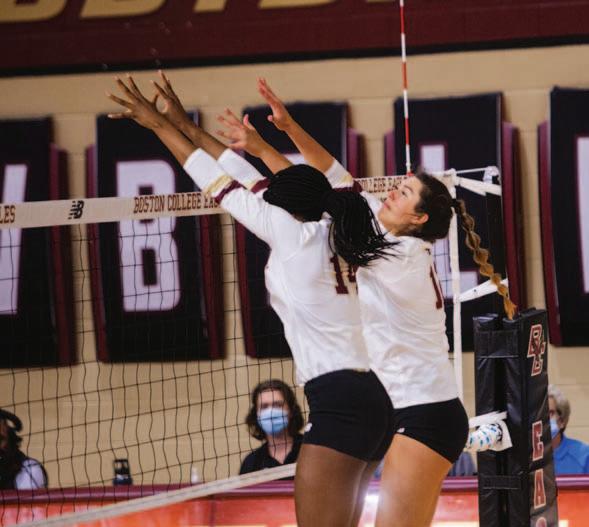
“She’s been amazing for this program, you know,” BC head coach Jason Kennedy said. “We rely on her for so many things, and being able to count on somebody as much as we have, for 1,000 kills, is huge. … She’s been absolutely integral to getting this thing going in the right direction.”
The Eagles (12–6, 2–2 Atlantic Coast) faced off against Wake Forest (10–5, 1–3) in their home gym, looking to go 2–0 for the weekend following a win over Virginia Tech on Friday. Despite coming back from down 2–0, the Eagles fell to Wake Forest in the fifth set.
The first set was even on both
sides, and the Eagles’ offense picked up thanks to the efforts of Gabby McCaa and Jenna Pollock. McCaa earned three blocks while Pollock earned five kills in the first set alone.
Wake Forest got hot late in the set, however, dominating the Eagles on the block. Despite a competitive first set, the Eagles saw set one go to the Demon Deacons 25–23.
Wake Forest came out with the same fire in the second set, forcing BC’s Amaka Chukwujekwu to make big-time plays. Chukwujekwu kept the Eagles in the game, earning two deadly kills and coming up with impressive blocks. The Demon Deacons started to run away with it in the second set, going up 18–10 and frazzling the Eagles’ offense. The Eagles stayed in it, and with Naughton serving, they went on to score seven straight points.
Katrina Jensen, who earned five kills in the second set and went on a scoring spree toward the end of the match, led the Eagles’ offense. Backto-back aces by Wake Forest’s Kamryn Malloy, however, allowed Wake Forest to take the second set 25–21.
“I think we just got off to a little bit too slow of a start,” said Kennedy.
Jensen showed off her skills again in the third set, dominating the offense with powerful kills. The Eagles went on a six-point streak to go up 16–15, brought on by powerful serves by Sophia Lambros. Despite a strong offensive showing, the Eagles couldn’t quite escape the grasp of Wake Forest, and they found themselves in a similar position as in the first two sets.
This time the Eagles had a response. They focused on getting the next point, going on yet another six-point streak to go up 23–20. With set point on the line, Naughton earned her 10th kill of the game, sending the match into a fourth set.
The Eagles communicated well in the fourth set, perfecting their positioning and forcing Wake Forest to make attacking errors. Wake Forest went up 25–24, but a perfectly placed kill by Naughton kept the Eagles alive.
Back-to-back kills by Chukwujekwu lifted the Eagles past Wake
Forest 27–25 in the fourth set, forcing a fifth and final set.
Jensen and McCaa showcased their skills in the fifth set, sending powerful hits that Wake Forest could not get under. It wasn’t enough for the Eagles, however,
who fell to Wake Forest 15–13 in the fifth set.
“I thought we played pretty well in the last three sets,” Kennedy said. “We just didn’t come out with that same energy and intensity in the beginning.”
BY Spencer Daniszewski For The Heights
An in-state rivalry game is sure to draw fireworks, especially when it’s between two nationally ranked teams with practically identical records. It’s just a question of how big those fireworks will be. Between No. 10 Boston College field hockey and No. 21 UMass Amherst, the fireworks were about as much of a spectacle as they could be.
After a tough-as-nails regulation, two overtime periods, and a shootout, UMass emerged with a hard-fought 3–2 victory after winning the shootout 8–7. BC led 2–0 after the first half, but a late surge from the Minutewomen handed BC its third loss of the year.
“I think we started out really well, with some players playing different positions and we got one on the board early on,” BC head coach Kelly Doton said after the game. “We just keep letting these teams back into these games that we’re controlling. It’s a tough loss.”
BC’s first goal came off the stick of Milagros Arteta in the first quarter. It marked her sixth goal of the season, and Jill Joossens earned credit for the assist. Just 13 minutes later, Sky Caron gave the Eagles a more comfortable lead on a goal from a penalty corner, putting the Eagles up 2–0 early.
But as the saying goes, a 2–0 lead is one of the most dangerous leads in sports. The Eagles’ defense held strong all the way through the second quarter, but it didn’t take long for the Minutewomen to get
one back in the third quarter.
The wheels began to fall off for the Eagles when UMass defender Katie Samaranayake scored off an assist from midfielder Amelie Green 40 minutes in. Green sent a penalty corner to Samaranayake, who buried it behind BC goaltender Jonna Kennedy for Samaranayake’s first goal of the season.
Still, BC was nursing a narrow lead, and the minutes had begun to wane. But with less than a minute remaining in regulation, a goal off the corner from junior midfielder Jess Beech sent the game into overtime.
“We’ve been letting in way too many goals and allowing too many fast breaks, so our defense was the focus all week,” Doton said. “We gave them too many corners and they scored off of them.”
After two scoreless overtime periods, the game went to the deciding shootout, and UMass midfielder Georgie McTear buried the eventual game winner in the eighth round.
The teams were about as statistically even as they could have been. Both UMass and BC finished with 15 total shots, and BC only narrowly edged UMass in shots on goal, 10–9. The difference maker was corners, as UMass earned seven penalty corners to BC’s three.
With games against No. 14 Virginia, Richmond, No. 3 Louisville, and No. 9 Saint Joseph’s on the horizon, BC’s road won’t get any easier.
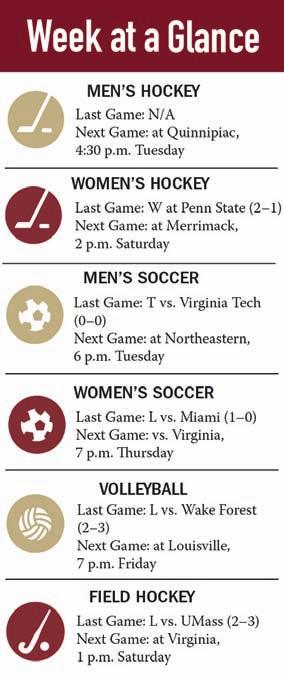
“Tough games. Tough games. We have no easy games on our schedule,” Doton said. “In the ACC, we’re 0–2 right now and then we go up against another great non-conference team, so we gotta be ready.”
BY EMMA HEALY Sports Editor
Prior to a weekend trip to Pegula Ice Arena in Happy Valley, Boston College women’s hockey had never taken on Penn State.
The Nittany Lions only joined the NCAA from the ACHA in 2012, struggling to earn one win in each of its first two seasons in the NCAA. After finishing last season 16–3–2 and falling from the College Hockey America Tournament semifinals, Penn State has put itself on the map, earning votes in the 2021–22 USA Hockey preseason poll.
Even against an unfamiliar opponent, however, the No. 8 Eagles (2–0) proved why they earned a top-10 spot in the nation, sweeping the weekend in State College with a 2–1 win over the Nittany Lions
(0–3–1) on Friday.
After a 2–1 overtime win for BC on Thursday, Penn State was out for revenge one day later, and less than five minutes into the contest, Natalie Heising netted a one-timer from Kiara Zanon to take an early lead.
With its breadth of goal scorers, however, BC was down but not out, and Caroline Goffredo tied the game up just four minutes later with her first career goal. Willow Corson forced a turnover at the blue line and sent the puck to Hannah Bilka—tied for second-most points on the team last season— who slotted it to Goffredo for the finish.
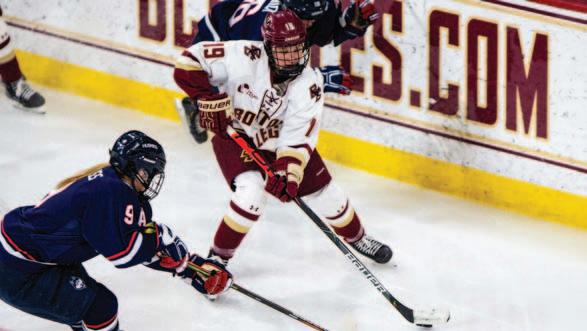
Goffredo saw minimal playing time as a freshman during the 2020–21 season, appearing in 14 games and registering three points, all on assists, but just four minutes into her sophomore campaign, the Mount Laurel, N.J. resident had tied up the game.
A scoreless rest of the first period passed, and BC came out hot in the second. Seven of BC’s 17 total shots came in the middle frame as the Eagles searched for the goahead goal. And just eight minutes in, they found it.
Bilka got the puck in the neutral zone and carried it all the way to the left circle, firing a cross-ice shot that found its way inside the right post for her first goal of the season. The tally also marked Bilka’s fifth game-winning goal of her career.
BC had three power-play opportunities but registered no shots while a man up. Penn State, on the other hand, fired off four shots in just over six minutes of man advantage.
Freshman Keri Clougherty added her first career point with an assist on Bilka’s goal. The Lynn, Mass. product also blocked three shots en route to the win.
Bilka and Goffredo’s goals were
two of just 17 shots the Eagles took all night. Penn State, meanwhile, peppered BC goaltender Abigail Levy with 34 shots, all but one of which she got in front of. For the second night in a row, the Minnesota State transfer kept the Eagles competitive under Penn State’s high-powered offense.
Fifteen of her 33 saves came in crunch time, with BC leading by just one goal in the third period. The Nittany Lions spent the majority of the frame in BC’s zone, but Levy stood tall, sending the Eagles home from their road trip with two wins and no blemishes on their record.
SPORTS A8 MONDAY, OCTOBER 4, 2021 THE HEIGHTS
IKRAM ALI / HEIGHTS EDITOR
The Eagles took down Penn State 2–1 in a non-conference contest.
The Eagles forced a fifth set after going down 2–0 but fell in the final frame.
Wake Forest Boston College 3 2 Boston College Penn State 2 1 UMass Boston College 3 2
STEVE MOONEY / HEIGHTS STAFF
BC Sweeps Weekend Series With Win Over
Eagles Let 2–0 Lead Slip, Fall To UMass
Penn State
PINIONS


The BaconEggandCheese Dilemma, and Other Things New England
New Jersey doesn’t exist, or so I’ve been told and b) My dad is from New Jersey and I’ve seen him go “Jersey” a time or two. I don’t think this needs a lengthy explanation, but it involves raised voices and hand gestures.



Coming from San Francisco, it feels like every other person I’ve met on campus is from New Jersey, Connecticut, or somewhere in Massachusetts. As a freshman in my first month of college, I have felt a little isolated at times because no one seems to miss home as much as I do. While I knew things were going to be different here (as I knelt on the floor of my dorm room on that first day quietly drowning in my own sweat and unpacking an embarrassingly full suitcase of sweaters and hoodies), I wasn’t quite prepared for how different.
I’ll just say things get pretty heated around here—and I’m not just talking about that little white box in my room that read an impossible 104 degrees on move-in day. When I casually mentioned to someone that I was from San Francisco while I was sitting uncomfortably on Stokes Lawn with sweat pooling in the creases of my bent legs, I was hit with this fiery retort:
“Oh, so you’ve never had a bagel before.”
The girl I had met just seconds before, who seemed full of sunshine and rainbows, turned “Jersey” on me in a split second.
“You wouldn’t know a real bagel if it hit you in the face.”
I say she “turned Jersey” on me because a) She was literally from New Jersey—but not central New Jersey because apparently, that part of
What I really wanted to tell her is that she wouldn’t know a real piece of avocado toast if it was offered to her on a rustic board, served on vegan, gluten-free, organic nut bread, and sprinkled with microgreens and chili pepper. But I figured that wasn’t the point she was trying to get at. Also, I was just too hot.
It was at this moment that I learned about the baconeggandcheese (did I call my New Jersey dad to confirm that the term was baconeggandcheese and not bageleggandcheese before writing this piece? Yes. Yes, I did). Pro tip: it must be referred to as one word. While I was dreaming of mashed avocados on ridiculously thick slabs of bread for the price of a studio apartment in Beacon Hill, my New Jersey counterparts were hankering for something a little more … substantial? Hearty? Meaty? All of the above.
As I partook in the frivolity on the morning of my first tailgate outside Alumni Stadium, I laid eyes upon my first official baconeggandcheese. Leaving no room for ambiguity, there, sandwiched between a bagel, was—you guessed it: bacon, egg, and cheese. As one of a handful of non-vegans in my hometown, I’ll say this: it was wicked good. (Did I say that correctly?)
As I laid in my bed many nights later, just dreaming of that baconeggandcheese and debating whether or not I even knew who I was anymore, I was shaken from my stupor by a crackling noise that suddenly took over the drone of the fans in my room. My California-trained brain ran through all possible end-of-day scenarios and
their corresponding solutions: Wildfire? Stop, drop, and roll. Earthquake? Duck and cover. Santa Ana wind? Sleep in the windbreaker that I hastily stuffed in my bag before leaving home. Turns out: none of the above.
What I found, when I stumbled out of my raised bed to rush to the window, was the exact opposite of a California disaster. It was a beautiful, glorious, torrential downpour, the likes of which could single-handedly reverse all drought in the great Golden State. And also thunder and lightning. Two things that we almost never experience. I went back to bed and fell quickly asleep. “Dammit, if Beantown wasn’t growing on me,” said the new girl in town. (Spoiler alert: That’s me.)
The next day, as I walked down the stairs toward the dining hall, decked out in a heavy-duty raincoat (note: everyone else was wearing shorts and a t-shirt), desperately gripping the hand railing and trying to avoid falling on my face (which I know will become a bigger battle once the snow sets in), I realized that not once in my life had I ever seen this much rain, and never, ever this much green.
I might not know a bagel from a button, or how to act in any weather situation other than 65 degrees and fog, but I do know that Massachusetts is trying its level best to teach this California girl some things. As long as I don’t boil alive or slip on some ice before the end of the year, and as long as I take some time to really listen to my bagel-expert friends, I know I’ll have some things to teach my California contingent when I make the trip back to my City by the Bay.
Tabitha Parent is an op-ed columnist for The Heights. She can be reached at tabitha.parent@bc.edu.

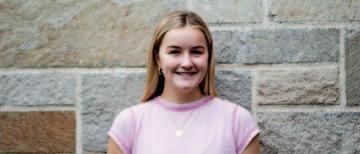
Family Weekend
Family Weekend was a wholesome display of just how much energy Boston College students, parents, and alumni bring to campus on game day. Family Weekend felt like a warm hug from the entire campus, and it proved that the undergraduate population can sit through an entire football game, plus overtime.
Coughing on Campus: The BC Plague
college playbook.
I remember the night that everything went wrong. Just like every other night, I was sitting in my twin XL bed mindlessly scrolling through social media, responding to emails, and of course, checking Herrd. Normally, checking Herrd means that I silently cackle at a variety of different, sort of stupid (but still funny) posts as my roommate tries to sleep. But that night was different. Instead of funny content about partying or the Class of 2025, my timeline read: “Is anyone else dying right now?” and “I’m hacking up my left lung no cap.” Under the glow of the pink LED lights in my Walsh bedroom, I knew something bad was about to happen. Unceremoniously, the next morning I woke up with “the tickle.” And dear God, did I wish I hadn’t. Like any good COVID-19-fearing college student, my first inclination was to panic. Thoughts like “Do I have COVID, or do I just need to sleep?” and “Oh my God if I test positive right now I’m going to miss parents’ weekend,” consumed my being as I made a beeline for the Plex’s testing center. Although I was panicking on the inside, I couldn’t let COVID-19 sense my fear. I pounded the Emergen-C equivalent of a moderate-sized orange grove and prepared to lay low until my results came back, a few queues from last year’s
A few very long and anxiety-driven hours later, I got my results back. Thankfully, I tested negative for COVID-19, but positive for something else: the BC Plague. And after my concerning scroll through Herrd the previous night, I knew my fate was sealed. From the looks of it, members of the BC community were dropping like flies, and campus was slowly morphing into a Petri dish. Even in the center of the loudest, most populated places on campus, the booming coughs and stuffy noses of the fallen could be identified. And even worse, the silence of Bapst was lost to the not-so-occasional sniffle.
Speaking as a member of the fatefully ill masses, classes that week were a physical and emotional battle. Armed with enough sanitizer to disinfect the most vile corner of my soul, I tried my best to keep it together. DayQuil, Liquid I.V., NyQuil, repeat, became my mantra as my symptoms became worse. I began to wear a mask to my classes once I realized that I couldn’t make it out of the classroom every time I felt the urge to cough or blow my nose.
For me, the decision to wear a mask was a complicated one. Part of me was concerned that wearing a mask would scare my classmates and friends into thinking I had been exposed to COVID-19 instead of just the generic BC Plague. But on the other hand, I felt odd going maskless, knowing that I was sick and potentially exposing others to the horrors of my ailments. This internal debate, I’ve grown to realize, is one that’s happening everywhere right now, and is a significant indication that things have changed. Personally, I think
it’s smart to wear a mask even if you’re sick with something other than COVID-19, simply from a peace-of-mind perspective. Even though the BC Plague is more annoying than anything else, no unsuspecting stranger would realize that you have the BC Plague, and not COVID-19, by the way you blow your nose or cough. Plus, if you’re sick, there is no better way to deflect judgmental glares than with a nice medical-grade mask. This minor change in, and discussion of, personal behavior is just one of the ways the world is changing in the wake of the pandemic. Think about it, a short two years ago it was deemed commendable to roll up to class on your deathbed. And now, as much as a sniffle will earn you a hoard of crude stares.
Although so much has changed over the past two years, all of that “change,” until now, has felt temporary. At the start of the pandemic, and even as recently as this summer, I always assumed that one day things would just go back to “normal.” But as we gradually ease into what could potentially be normal, I’ve begun to make my peace with the fact that things will probably never be exactly the same as before. I don’t feel old enough to witness widespread societal change, but I guess I don’t really have a choice. Now, I imagine myself as an old woman, telling anyone who listens that “Back in my day, we went to school sick!” and “Your grandma lived through the global pandemic!” But until then, I send my sincerest condolences to anyone that has been victimized by the BC Plague and I hope we all stop coughing soon.
Cameron Walker is an op-ed columnist for The Heights. She can be reached at cameron.walker@bc.edu.
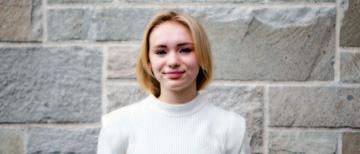
Sympathizing With the Sick
Speaking of community, another display of BC’s unity is the camaraderie of sick students. As the tickle ravages through campus, roommates in quads, eight mans, and even the valiant knights in Roncastle alike are facing an attack on all fronts in the thick of the Russian winter. And yet, instead of pointing fingers, there is a collective understanding that in the same way we rush the field together, we also sympathize with the effort it takes to suppress a cough in a 9 a.m. class.
Doors on Campus
Looking for dinner and a show on campus? Search no further than the doors outside of Lower, where you can see anyone attempting to enter awkwardly by yanking at the handles in a slow-burn, enemies-to-lovers battle that ultimately ends with other students quickly shuffling behind to avoid the losing fight.
Lost Water Bottles
Long ago (last semester), comfort water bottles were commended as a huge thumbs up, and this status still remains true. But, as dearly beloved as they are, water bottles are forgotten and left behind far too often. Hydro Flasks, S’wells, YETIs, and Nalgenes clutter the Rat, O’Neill, and various locations on campus like pockets of the Island of Misfit Toys. This thumbs down is not to encourage randomly adopting a water bottle (Please do not do that for the sake of UHS), but to remind you to pick up your travel buddy and not to leave it behind!
O
A9 MONDAY, OCTOBER 4, 2021 THE HEIGHTS
TABITHA PARENT
CAMERON WALKER
The opinions and commentaries of the op-ed columnists appearing on this page represent the views of the authors of those particular pieces, and not necessarily the views of The Heights
GRAPHIC BY HEIDY LEE / HEIGHTS STAFF

 MEGAN KELLY News Editor
MEGAN KELLY News Editor












 By Julia Remick Metro Editor
By Julia Remick Metro Editor






































